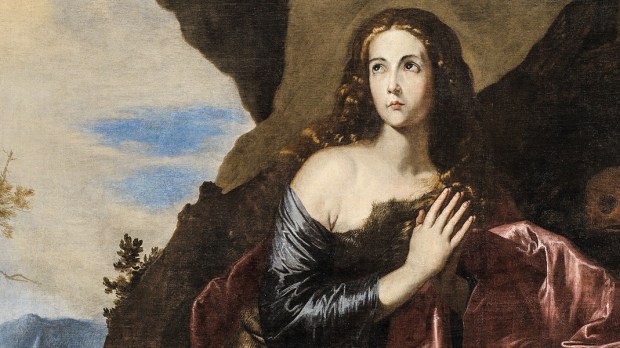On Saturday, the Church celebrates the Feast of St. Mary Magdalene – a liturgical observance of the second highest order. Feasts with a capital F are usually reserved for apostles and evangelists, those who played a significant role in the proclamation of the Gospel and the building up of the Church.
Although Mary Magdalene, as a figure mentioned prominently in the Gospels, has been honored among Christians from the beginning, it was only last year that Pope Francis elevated her feast day to a capital-F Feast. It’s worth revisiting the decree issued by Cardinal Sarah of the Congregation for Divine Worship and the Discipline of the Sacraments to understand the Holy Father’s reasoning:
… precisely because she was an eyewitness to the risen Christ, she was also the first one to bear witness to him before the Apostles. She fulfils the command of the Risen Lord: “‘Go to my brethren and say to them, I am ascending to my Father and your Father, to my God and your God.’ Mary Magdalene went and announced to the disciples ‘I have seen the Lord’ and she told them that he had said these things to her” (Jn 20:17-18). Thus, as already indicated she becomes an evangelist, that is a messenger who announces the Good News of the Lord’s resurrection or, as Rabanus Maurus and Saint Thomas Aquinas say, she becomes the “apostolorum apostola” [apostle to the Apostles] because she announces to the apostles what in turn they will announce to the whole world (Rabanus Maurus, De vita beatae Mariae Magdalenae, XXVII; Saint Thomas Aquinas, In Ioannem Evangelistam Expositio, c. XX, L. III, 6). It was with good reason that the Angelic Doctor applied this term to Mary of Magdala, for she is the witness to the risen Christ and announces the message of the Lord’s resurrection just like the rest of the Apostles. For this reason it is right that the liturgical celebration of this woman should have the same rank of Feast as that given to the celebration of the Apostles in the General Roman Calendar and that the special mission of this woman should be underlined, she who is an example and model for all women in the Church.

Read more:
How to tell a feast day from a feast (and a solemnity, and a memorial)
“The special mission of this woman …” If, indeed, Mary Magdalene is to be “an example and model for all women” – and, I would add, for all Christians – we need to take time to ponder the real nature of that mission, the real person of Mary Magdalene.
We might be excused if that’s difficult. Millennia of tradition and legend and artistic license and conspiracy theory have shaped our notion of “this woman.” Which of these examples are we called to follow?
Is she – as the Western Church has taught, and artists have painted – the unnamed penitent woman, notorious for her sins, who received forgiveness from Jesus? In times of asceticism, her sins were identified as those of the flesh, and she was painted in both sermons and portraits as a wealthy and beautiful prostitute who gave up her jewels and her finery and her lovers to take up a life of desert penitence.
Certainly, if this was her mission, turning from sin is a worthy example for us all.
Or is she – as is also traditionally believed in Western Christianity – the sister of Martha and Lazarus, member of the family beloved by Jesus and the one who “chose the better part” by listening with rapt contemplation to his teachings?
A friend of Jesus, one who knows that the most important thing is listening to him – that’s a mission and a model worth following.
She’s not, we know, the woman of the Gnostic writings who is singled out by Jesus as wiser than the average Apostle, the one who “makes herself a man” to enter the Kingdom of God. Nor is she Jesus’ secret wife, the human Holy Grail of his bloodline, as popular fiction (building on years of occult legends) would have us think. The feminist Mary Magdalene and the Divine Feminine Mary Magdalene may satisfy a need some have for a better balance in this fallen world of broken gender relationships, but neither is a model anyone can follow, and neither has a mission we all can emulate.
Last year’s decree, acknowledging some of these past and sometimes flawed understandings, asks us to focus on “this woman,” this Mary of Magdala, as we do know her most truthfully: in the Gospels.
From them we know Mary Magdalene as a disciple, a woman healed by Jesus from demonic torment. She helped fund Jesus’ ministry out of her own resources. She stood by him at the foot of the cross when the others – except for his Mother and John, and a handful of other women – fled in fear or disappointment. She wept at his tomb, to which she had come bearing costly burial ointment.
And there in that garden, Mary Magdalene encountered the Risen Christ. She was the first person to whom he directly appeared, the first to be sent by him as an apostle to evangelize, to bring the Good News of his resurrection. “Don’t cling to me,” he told her. “Go!” And she did.
There it is. She loved him, she followed him, she shared in his last agony, and when he told her to go and evangelize, she did. That was “the special mission of this woman,” and it is one to which each of us is called and of which each of us is capable.
Legends and non-canonical writings and paintings and Dan Brown novels aside, we do not hear of Mary Magdalene again. She disappears, as the Risen Christ disappears at Emmaus, passing the mission to us, the disciples. This Saturday, as we celebrate the Feast of the Apostle to the Apostles, let us love and follow Jesus as she did, come to him for healing as she did, support the Gospel out of our resources as she did, stand by his cross as she did, and go gladly where he sends us.
St. Mary Magdalene, pray for us!

